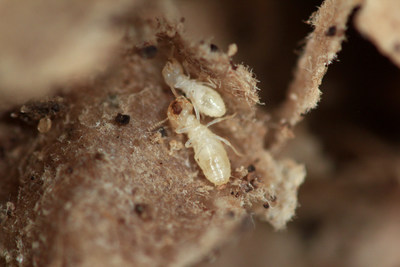ATLANTA, March 4, 2019 /PRNewswire-HISPANIC PR WIRE/ — Pest control leader Orkin reveals Miami as the front runner of its first-ever Top 50 Termites Cities list, released today. Los Angeles follows in second place, with Tampa, New York and New Orleans rounding out the top five, respectively.

When it comes to types of termites, all areas of the U.S. are prone to subterranean termites with concentrations from slight to very heavy. Pacific U.S. and coastal regions of the Southeast have an additional threat of drywood termites.
The list is based on treatment data from the metro areas where Orkin performed the most first-time customer termite treatments from February 1, 2018 – January 31, 2019. The ranking includes both residential and commercial treatments.
|
1. Miami |
26. Mobile, Ala. |
|
2. Los Angeles |
27. Indianapolis |
|
3. Tampa |
28. Cincinnati |
|
4. New York |
29. Pittsburgh |
|
5. New Orleans |
30. Kansas City |
|
6. Atlanta |
31. Richmond, Va. |
|
7. Washington, D.C. |
32. Honolulu |
|
8. West Palm Beach |
33. St. Louis |
|
9. San Francisco |
34. Oklahoma City |
|
10. Dallas |
35. Tulsa |
|
11. San Diego |
36. Denver |
|
12. Orlando |
37. Columbia, S.C. |
|
13. Phoenix |
38. Jacksonville |
|
14. Houston |
39. Lexington |
|
15. Raleigh, N.C. |
40. San Antonio |
|
16. Philadelphia |
41. Chattanooga, Tenn. |
|
17. Baltimore |
42. Columbus, Ohio |
|
18. Nashville |
43. Grand Rapids, Mich. |
|
19. Chicago |
44. Boston |
|
20. Charlotte, N.C. |
45. Charleston, S.C. |
|
21. Ft. Myers |
46. Baton Rouge |
|
22. Norfolk, Va. |
47. Louisville |
|
23. Knoxville |
48. Savannah, Ga. |
|
24. Greenville, S.C. |
49. Roanoke, Va. |
|
25. Charleston, West Va. |
50. Champaign, Ill. |
Species generally swarm based on favorable weather conditions. Most species of subterranean termites swarm in the spring and summer, a time frame when homeowners are more likely to notice signs of an infestation. Drywood termites typically swarm during the late summer or fall months, from August through November. Varying conditions may mean that swarms will occur at different times.
When they’re ready, termites emerge searching for the ideal environment of warmth, moisture and food. And because of urbanization, there are fewer dead trees lying around, so termites will find their way to other sources of wood such as residential properties.
“Often called the ‘silent destroyer,’ termites can secretly hide and thrive in your home, property or yard without any immediate signs of damage for years,” said Glen Ramsey, an Orkin entomologist. “U.S. residents spend an estimated $5 billion annually to control termites and repair termite damage – which occurs in approximately 600,000 homes each year.”
Termites invade properties by foraging from their colonies in search of food resources and finding home foundations. Cracks or gaps around pipes and wires give the pests access inside.
“Termites are the ultimate workaholics – they chew constantly causing extensive damage over time. Some enter structures through wood-to-ground contact by building shelter tubes or entering directly through cracks in the foundation as small as 1/32 of an inch – about the thickness of a business card.”
These pests are a threat to your household and beyond, so it’s critical to detect and treat for them as early as possible. Anyone who suspects a termite introduction should contact a pest management professional immediately.
Property owners can get termites from:
- Wooden structures, such as porches and decks, in direct contact with the ground
- Stacks of firewood that lean against the house
- Damp soil near foundations from leaking faucets, gutters or downspouts
- Trees and shrubs in close proximity to the house
- Above-ground locations in the house that remain damp enough to support termites without them needing to return to the moist conditions found in the soil
Signs of a termite infestation include:
- A temporary swarm of winged insects in your home or from the soil around your home
- Any cracked or bubbling paint or frass (termite droppings)
- Wood that sounds hollow when tapped
- Mud tubes on exterior walls, wooden beams or in crawl spaces
- Discarded wings from swarmers
Proactive tips that Orkin recommends for homeowners:
- Check water drainage sites to ensure they remain cleared and effective.
- Monitor the collection of moisture by fixing pipes, gutters, downspouts, A/C units and other fixtures susceptible to leaking.
- Caulk around utility lines or pipes.
- Get rid of rotting wood and debris near the home.
- Place screens on outside vents.
- Check wooden structures for damage.
For more information about termite prevention, visit Orkin.com.
About Orkin, LLC
Founded in 1901, Atlanta-based Orkin is an industry leader in essential pest control services and protection against termite damage, rodents and insects. The company operates more than 400 locations with almost 8,000 employees. Using a proprietary, three-step approach, Orkin provides customized services to approximately 1.7 million homeowners and businesses in the United States, Canada, Mexico, Europe, South America, Central America, the Middle East, the Caribbean, Asia, the Mediterranean and Africa. Orkin is committed to studying pest biology and applying scientifically proven methods. The company collaborates with the Centers for Disease Control and Prevention (CDC) and eight major universities to conduct research and help educate consumers and businesses on pest-related health threats. Learn more about Orkin at Orkin.com. Orkin is a wholly-owned subsidiary of Rollins Inc. (NYSE: ROL). Follow us on Facebook and LinkedIn.
Photo – https://mma.prnewswire.com/media/828762/Orkin_LLC_Termites_up_close.jpg
SOURCE Orkin, LLC






